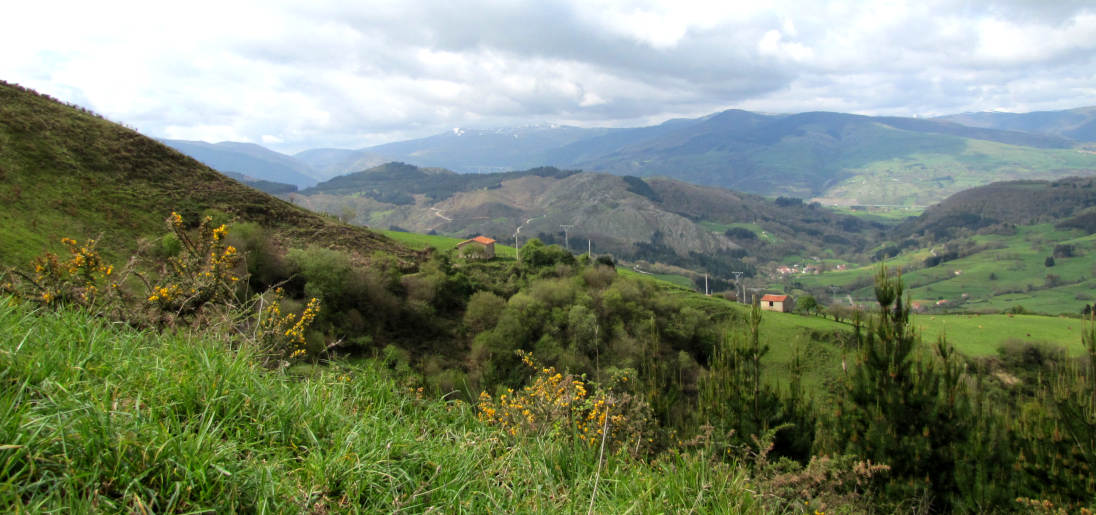
Cantabria and the Basque Country
Northern Spain from Picos de Europa to the Pyrenees
About-Spain.net - the alternative guide to Spain
| On this page: | Cantabria | Basque Country | Other sites |
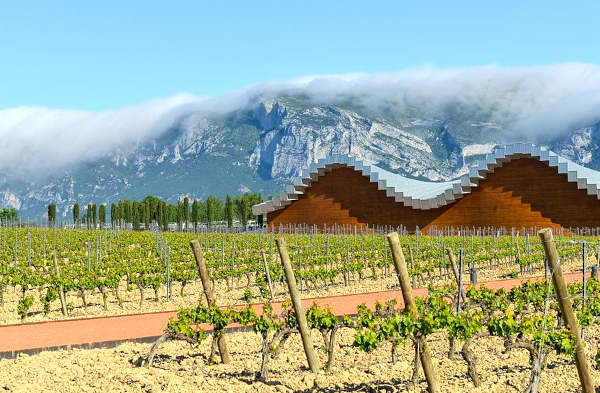
Vineyards in Southern
Alava, near the border with Rioja.
From the prehistoric heritage of the caves at Altamira in Cantabria to the stunning architectural forms of Frank Gehry's remarkable Guggenheim Museum in Bilbao; from the beautiful sandy coves and beaches of the Atlantic coast to the arid hills and the vineyards la Rioja Alavesa in the south of the Basque Country.... this area is rich in contrasts, rich in monuments, and rich in places to discover for those in search of the great outdoors.
The top two photos on this page - a valley near the coast and a vineyard in southern Alava, clearly illustrate the diversity of this beautiful part of Spain.
Cantabria

Santander - harbour and city.
A stopover in Cantabria is worth considering. Like the Basque country to the east, and Asturias to the west, Cantabria is a region where mountains come down to the coast, a region whose climate is tempered by the Atlantic ocean. This is one of the regions of "Green Spain" where the summers are not too hot, the winters not too cold, and spring comes early.
Almost half the population of Cantabria live in the Santander metropolitan area, meaning that the rest of the region is essentially rural, with small towns. Santander is a prosperous port city whose name has been taken worldwide by its most famous company, the Banco de Santander, Spain's largest bank, and the fifth largest in Europe.
Humans have lived in this area since prehistoric times, and the UNESCO World Heritage site of Altamira has one of the finest collections of paleolithic cave paintings. The caves have been closed to the public since 2002 for reasons of conservation; however as at Lascaux in France, a replica cave has been constructed nearby.
Basque country
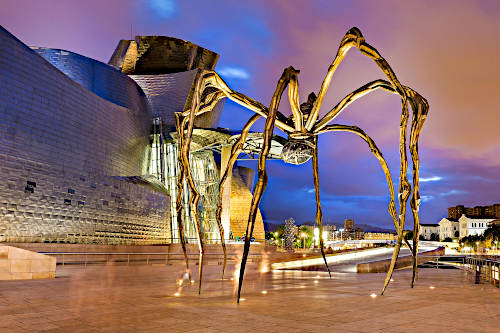
Statue outside the spectacular Guggenheim Museum in Bilbao
Like Catalonia, the historic Basque Country, which the Basques call Euskadi, includes areas on both sides of the Pyrenees – in France and Spain, as well as much of Navarre to the east. And while the French Basque Country is just part of the Pyrénées Atlantiques department, the Spanish Basque Country is one of Spain's fully-fledged "autonomous communities", or regions. It is also the wealthiest region in Spain, measured in terms of per capita GDP.
The wealth of the Basque Country stems from its natural resources and its industrial heritage. With its steep valleys, easy access to the sea, and (by Spanish standards) abundant rainfall, the Basque country of Spain was the home of the Industrial Revolution in Iberia; and while deindustrialization has taken its toll, Bilbao, the largest city in the Basque country, remains the third wealthiest city in Spain after Madrid and Barcelona.
For visitors and tourists, the Basque Country has plenty to offer, and its most visited attraction is the remarkable Guggenheim Museum in Bilbao, designed by Frank Gehry and opened in 1997 as the focal point in the regeneration of the city's old docklands. The museum is recognised as one of the most stunning buildings of the 20th century, and one of the world's leading contemporary arts museums. A short walk south along the quays is the Casco Viejo or old town, with its narrow pedestrian streets, squares, cafés, restaurants and shops and other museums.
The Basque Country's other major city is the port city of San Sebastian (in Spanish) or Donostia (in Basque), located just 20 km into Spain from the French border at Irun. Though there has been a city here since the Middle Ages, today's San Sebastian is mostly a 19th and 20th century city, popular for its festivals; however the Parte Viejo, or Old Quarter, situated on an isthmus at the foot of Mount Urgull, is older. Mount Urgull, dominated by the fortress of La Mota, offering spectacular views over the city, along the coast, and into the interior.
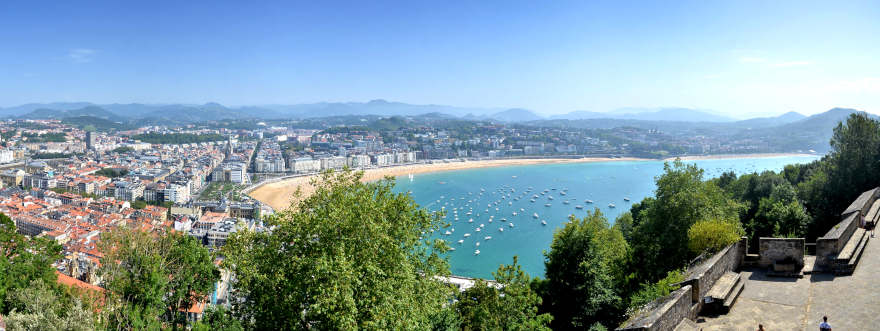
La Concha beach in the middle of San Sebastian, from Mount Urgell and la Mota.
.Indeed, it is the coasts of the Basque country that are its major attraction; the Basque Country hills come right down to the sea, giving the area a rocky coast characterised by steep cliffs, small seaside villages and harbours, inlets sandy coves and beaches many of them well off the tourist trail.
Most of the Basque Country is hilly or mountainous, and after San Sebastian, the motorways in the direction of Central Spain rise steadily through narrow valleys and up to an altitude of around 800 metres, before dropping down to Vitoria / Gasteiz, the capital of the Basque Country at 500 metres above sea level.. Vitoria, reputedly Spain's "greenest" city, has an old quarter with attractive squares, old churches and museums, is also capital of the Alava district, the drier part of the Basque Country, which extends to the Ebro valley and the border with the Rioja region. The southern part of Alava, around the Ebro valley is itself a reputed wine growing area, with some fine wineries to visit, including one with a hotel designed by Frank Gehry (See Guggenheim museum above).
Other places, other sites
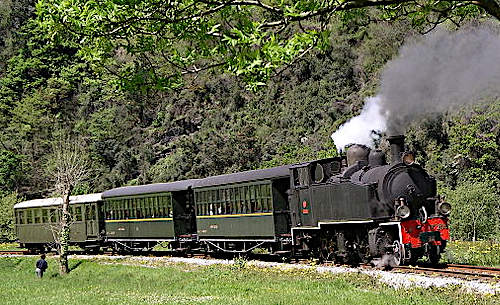
Historic narrow gauge train at Azpeitia
In the hills and along the coast there are plenty more hiking trails, such as the Arcos de Llanegro circuit at Lienda, on the Cantabrian coast northwest of Bilbao, and some grulling high mountain trails in the Picos de Europa national park on the border with Asturias.
Railway enthusiasts, or just thouse in search of a bit of nostalgia, will find two attractions in the Basque Country. The first is the Basque Railway Museum at Azpeitia, reputedly one of the best in Europe (Open April to November), where visitors can enjoy a 5 km trip in an old train pulled by a historic steam lodomotive.
For longer journeys, Northern Spain as a historic network of narrow gauge routes that actually connect with French TGV services in Hendaye. In the San Sebastian and Bilbao areas, the metre-gauge routes are an integral and modern part of the urban and suburban transit networks. Elsewhere they offer bucolic trips through the spectacular scenery not just in the Basque Country and Cantabria, but as far as Leon in Castile, and Santiago de Compostella in Galicia. Spain's most famous luxury train, the Transcantabrico makes the journey once a week in each direction in the tourist season. The trains are like moving luxury hotels, taking a week to travel from San Sebastian to Santiago de Compostella, or vice-versa, with stop-offs to visit the most interesting sites along the route.
However there's no need to pay thousands of euros to enjoy a week of mobile luxury. Ordinary train services operate two or three times a day in each direction along the coastal route, so for example a day trip from Santander to the picturesque fishing port of Llanes is easy to arrange. There is a daily train each way between Bilbao and Leon. Take care if wanting to book. The narrow gauge lines are run by FEVE, a parte of Spain's RENFE, but tickets are not available from online booking sites including Trainline and Renfe's own booking site. Try using these and - unless things change - you'll either get no offer, or get a ticket on a normal Renfe route. Travel blogs suggest that it's best just to turn up at the station and buy a ticket. There are no reserved seats anyway.
Other
pages of interest :
- Andalucia - Extremadura - Valencia
- Undiscovered
Spain - The coasts
of Spain - Travel
in Spain
- Food
and eating in Spain - Driving in Spain
- Spanish
motorway map
Photo top of page: early February in the Basque Country, an area where spring comes early.
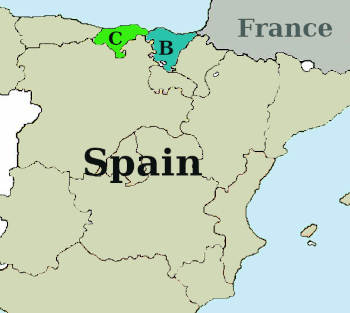
Cantabria and the Basque Country
Cantabria and Basque Country
hotel finder :
hotel finder :
 For
the independent traveller, a choice of hotels and hostales in the
Basque Country and Cantabria.
For
the independent traveller, a choice of hotels and hostales in the
Basque Country and Cantabria.► Select city or area & star rating
for a broad choice of hotels and the best discounted online booking rates available.
| City / area | Budget hotels |
Quality hotels |
| Bilbao | 1-star | 3-star |
| 2-star | 4-star + | |
| Basque Country | 1-star | 3-star |
| 2-star | 4-star + | |
| Cantabria | 1-star | 3-star |
| 2-star | 4-star |
These links will take you to Booking.com, Europe's leading online hotel booking portal .
As an affiliate partner, About-Spain may receive a small commission on bookings on this site; this has no effect on the price charged to the user.
You may also like Small hotels in Northern Spain on Independent-hotels.ingo
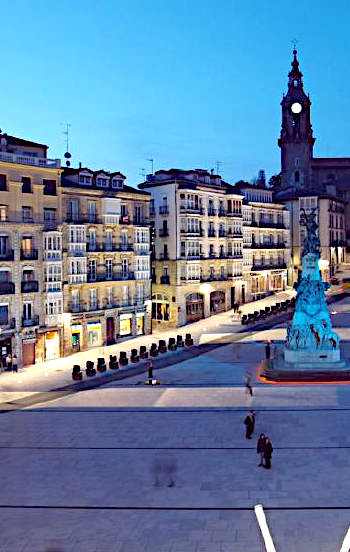
Vitoria / Gasteiz is the capital of the Basque Country
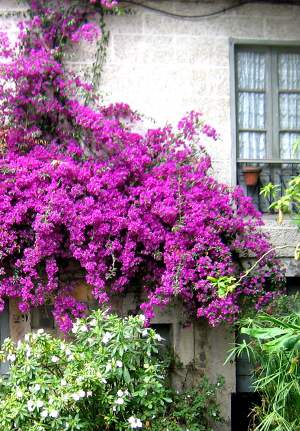
Bougainvillia grows profusely in the mild atlantic climate of coastal northern Spain
Access
Getting to the Basque Country and Cantabria:By car via the southwest corner of France (A10 from Paris) via Bordeaux and Bayonne.
By ferry: Brittany ferries operate direct ferries from Portsmouth and Plymouth to Bilbao and Santander
Fly to Cantabria and the Basque country: Ryanair (2023) has flights to Santander from London Stansted, Birmingham, Manchester and Edinburgh, as well as Beauvais and Charleroi., and from London Stansted and Charleroi to Biarritz
Neighbouring
regions :
- Castile and Leon - to the south
- Asturias - to the West
- Navarre - to the east
- New Aquitaine (France) to the north
| ►► Spain - a thematic guide: |
| Spain - the country Essential information about Spain. |
| Driving
in Spain Getting round Spain by car - roads and driving tips |
| Spain by train A guide to taking the train in Spain |
| Tourism
in Spain
Where to go and what to see |
| The coasts of spain |
| Top attractions in Spain |
| Andalucia |
| Eastern Andalucia |
| Western Andalucia |
| Asturias |
| Castile y Leon |
| Castile La Mancha |
| Extremadura |
| Valencia |
| Undiscovered Spain |
| Map of the Spanish regions |
| Accommodation
in Spain Where to stay, and the different options available |
| Spanish food and eating |
Photos and text copyright About-Spain.net
Except photo of Vitoria by Mickelcg - Licence Creative Commons 4
Vineyards in Alava by Gilles Messian - Licence Creative Commons 2.0
La Concha Beach © by Donostia San Sebastian Turismoa - Ivan Andrejic- secreteditions.com .
Guggenheim Museum by Designerpoint,- Licence Creative Commons 2.0

